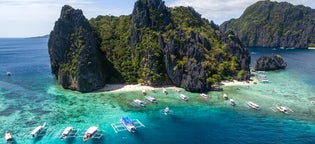17-Day Natural Wonders, Islands & Heritage Tour to Puerto Princesa, Cebu, Bohol & Ilocos from Manila





Description
Summary
Description
Explore the natural wonders, islands, and heritage of the Philippines with this 17-day tour package. From Manila, you will see the historical and cultural landmarks of Ilocos and Cebu and the breathtaking natural wonders of Bohol and Puerto Princesa. This package has pre-arranged accommodations, daily breakfast, transfers, entrance fees, and the service of guides for your convenience.
On your first day in the country, you will explore the walled district of Intramuros in Manila. There are several Spanish-era landmarks housed in this historic area, one of which is the iconic Fort Santiago. From the capital, you will then fly to northern Luzon and visit the Malacanang of the North, Marcos Museum, and Bangui Windmills in Ilocos Norte. Your guide will also bring you on a walk down the cobblestone street of Calle Crisologo in Vigan.
After your Ilocos trip, you will proceed to the highlands and explore the primary hotspots here, including the Sumaguing Cave in Sagada. You will also go to Banaue Museum in Banaue, Camp John Hay and Mines View Park in Baguio, and the Strawberry Farm in Benguet. Following this, you will go hiking in Mt. Pinatubo to see its stunning crater lake.
From Luzon, you will board a plane to Bohol, where the Tarsier Sanctuary and Chocolate Hills are located. Enjoy exploring the countryside of this province before jumping on a ferry to see Apo Island in Dumaguete.
Afterward, you will head to the neighboring island of Cebu for some wet activities in Kawasan Falls and Pescador Island and a highland adventure at Temple Of Leah and Sirao Flower Farm. You will then cap off the trip at Puerto Princesa in Palawan. Here, you will go on an island-hopping across Honda Bay and a cruise down the Underground River.
Visit the Philippines and go on this 17-day vacation package to Manila, Ilocos, Sagada, Banaue, Benguet, Tarlac, Bohol, Dumaguete, Cebu, and Puerto Princesa. Check availability by choosing a date.
Included
Map
Attractions
Activities
Daily itinerary

Day 1 - Day 1: Intramuros Tour

Day 2 - Day 2: Laoag Tour

Day 3 - Day 3: Pagudpud Tour

Day 4 - Day 4: Vigan Tour

Day 5 - Day 5: Sagada Tour

Day 6 - Day 6: Banaue Tour

Day 7 - Day 7: Baguio Tour

Day 8 - Day 8: Benguet Tour

Day 9 - Day 9: Mt. Pinatubo Tour

Day 10 - Day 10: Bohol Countryside Tour

Day 11 - Day 11: Bohol Pamilacan Island Tour

Day 12 - Day 12: Apo Island Tour

Day 13 - Day 13: Kawasan Falls & Moalboal Sardine Run Tour

Day 14 - Day 14: Cebu City Tour

Day 15 - Day 15: Puerto Princesa Honda Bay Island Hopping Tour

Day 16 - Day 16: Puerto Princesa Underground River & City Tour

Day 17 - Day 17: Departure to Manila
What to bring
Good to know
Please bring appropriate clothing. Please be aware that your itinerary may have to be rearranged to fit your arrival date and time better.
All our guides speak English. For other languages, contact us for availability and rates.
Not all establishments accept credit or debit cards, and ATMs can be limited.
The season for dolphin watching in Dumaguete is from March to October and is subject to weather and wind conditions. If off-season or on days when the northeast monsoon is strong, dolphin watching may not be possible. During Habagat/ Southwest monsoon Season (June-October), boat ride to Apo Island may be rough.
Accommodation
See our accommodation levels below and our preferred accommodation partners under each day in the daily itinerary. All accommodation levels, bookings for one person will be arranged in single rooms, bookings for two or more people will share a twin/double, and odd number groups will always be allocated a single room. If you are travelling in a group, but prefer a single room, please make separate bookings. Teenagers and children will be arranged in the same room with parents. If additional room(s) is needed, additional costs will incur.
For multi-day guided tours, accommodation cannot be upgraded and the levels below do not apply. Guide to the Philippines will provide you with the best available accommodation at the time of your booking from our preferred partners. If our preferred partners are fully booked at the time of your booking, we will find another suitable accommodation for you of similar level.
We always do our best to accommodate special requests, which may incur additional costs. Press choose a date to find availability.
Private rooms with private bathrooms in guesthouses or small hotels with basic amenities.
Private Rooms with a private bathroom at three-star hotels or resorts located in the city center, in close vicinity, or near the beach area. Breakfast is included and with basic room amenities and toiletries.
Rooms at four-star to a five-star hotel in the city center or beachfront resort with a private bathroom at the absolute best locations with the best amenities, facilities, and services.
Similar tours

Download the Philippines’ biggest travel marketplace to your phone to manage your entire trip in one place
Scan this QR code with your phone camera and press the link that appears to add the Philippines’ biggest travel marketplace into your pocket. Enter your phone number or email address to receive an SMS or email with the download link.








